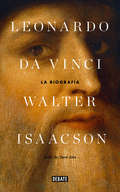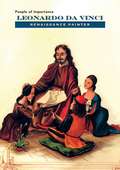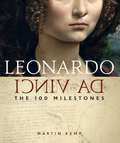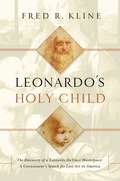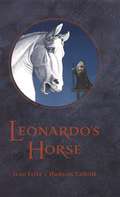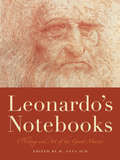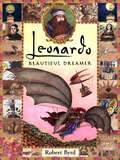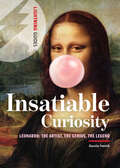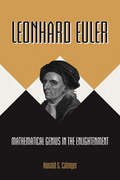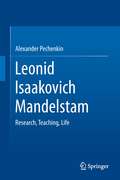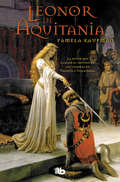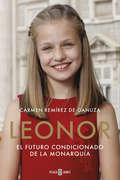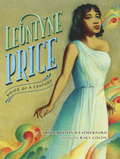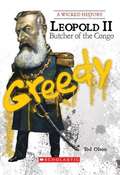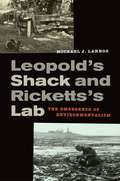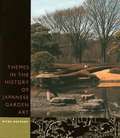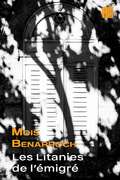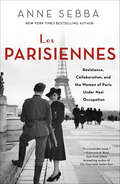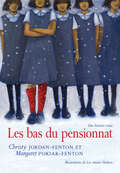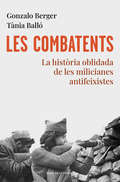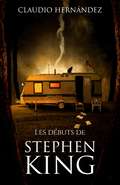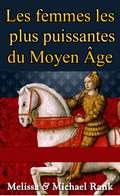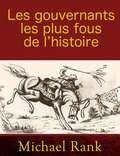- Table View
- List View
Leonardo da Vinci: La biografía
by Walter IsaacsonEl aclamado autor de los best sellers Steve Jobs y Einstein nos vuelve a cautivar con la vida del genio más creativo de la historia en esta fascinante biografía. Basándose en las miles de páginas de los cuadernos manuscritos de Leonardo y nuevos descubrimientos sobre su vida y su obra, Walter Isaacson teje una narración que conecta el arte de Da Vinci con sus investigaciones científicas, y nos muestra cómo el genio del hombre más visionario de la historia nació de habilidades que todos poseemos y podemos estimular, tales como la curiosidad incansable, la observación cuidadosa y la imaginación juguetona. Su creatividad, como la de todo gran innovador, resultó de la intersección entre la tecnología y las humanidades. Despellejó y estudió el rostro de numerosos cadáveres, dibujó los músculos que configuran el movimiento de los labios y pintó la sonrisa más enigmática de la historia, la de la Mona Lisa. Exploró las leyes de la óptica, demostró como la luz incidía en la córnea y logró producir esa ilusión de profundidad en la Última cena. La habilidad de Leonardo da Vinci para combinar arte y ciencia -esplendorosamente representada en el Hombre de Vitruvio- continúa siendo la regla de oro de la innovación. La apasionante vida de este gran hombre debe recordarnos la importancia de inculcar el conocimiento, pero sobre todo la voluntad contagiosa de cuestionarlo: ser imaginativos y pensar de manera diferente.
Leonardo da Vinci: La biografía
by Walter IsaacsonEl aclamado autor de los best sellers Steve Jobs y Einstein nos vuelve a cautivar con la vida del genio más creativo de la historia en esta fascinante biografía. Basándose en las miles de páginas de los cuadernos manuscritos de Leonardo y nuevos descubrimientos sobre su vida y su obra, Walter Isaacson teje una narración que conecta el arte de Da Vinci con sus investigaciones científicas, y nos muestra cómo el genio del hombre más visionario de la historia nació de habilidades que todos poseemos y podemos estimular, tales como la curiosidad incansable, la observación cuidadosa y la imaginación juguetona. Su creatividad, como la de todo gran innovador, resultó de la intersección entre la tecnología y las humanidades. Despellejó y estudió el rostro de numerosos cadáveres, dibujó los músculos que configuran el movimiento de los labios y pintó la sonrisa más enigmática de la historia, la de la Mona Lisa. Exploró las leyes de la óptica, demostró como la luz incidía en la córnea y logró producir esa ilusión de profundidad en la Última cena. La habilidad de Leonardo da Vinci para combinar arte y ciencia -esplendorosamente representada en el Hombre de Vitruvio- continúa siendo la regla de oro de la innovación. La apasionante vida de este gran hombre debe recordarnos la importancia de inculcar el conocimiento, pero sobre todo la voluntad contagiosa de cuestionarlo: ser imaginativos y pensar de manera diferente.
Leonardo da Vinci: Renaissance Painter
by Brendan JanuaryKnown for his art, inventions, and ideas, Leonardo da Vinci is the definition of a "Renaissance Man," someone able to succeed in many different areas. Da Vinci's Mona Lisa and The Last Supper are two of the most famous paintings in history. His sketches of inventions and the human body have stayed in the minds of people for hundreds of years. Da Vinci's work and ideas have lived on long after he died, inspiring creative people in the modern world to reach new heights. Learn the story of one of the most important artists of all time in Leonardo da Vinci: Renaissance Painter.
Leonardo da Vinci: The 100 Milestones
by Martin KempTo commemorate the 500th anniversary of Leonardo da Vinci&’s death, world-renowned da Vinci expert Martin Kemp explores 100 of the master&’s milestones in art, science, engineering, architecture, anatomy, and more. Leonardo da Vinci was born in the small Tuscan town of Vinci in April 1452. Over the centuries, he has become one of the most famous people in the history of visual culture. Spring 2019 marks the 500th anniversary of his death in May 1519, with exhibitions and events planned across Europe and the United States. This lavishly illustrated volume by Martin Kemp—one of the world&’s leading authorities on da Vinci—offers a fresh way of looking at the master&’s work. Kemp focuses on 100 key, broadly chronological milestones that cover an extraordinary range of topic across Leonardo&’s many fields of discipline: painting, where he brought new levels of formal and emotional grandeur to his works, including The Last Supper and Portrait of Lisa del Giocondo (the &“Mona Lisa&”); anatomical studies, which are extraordinary for their sense of form and function (Studies of the Optics of the Human Eye and Ventricles of the Brain); engineering marvels, noted for their range and extraordinary visual quality (Gearing for a Clockwork Mechanism and Wheels without Axles and Designs for a Flying Machine); and his progressive engagement with a range of sciences—anatomy, optics, dynamics, statics, geology, and mathematics.
Leonardo's Holy Child: A Connoiseur's Search for Lost Art in America
by Fred R. KlineA single sketch becomes an all-consuming quest to understand and identify a work by Leonardo da Vinci himself--the first new drawing by the great master to have surfaced in over a century. Fred Kline is a well-known art historian, dealer, connoisseur, and explorer who has made a career of scouring antique stores, estate sales, and auctions looking for unusual--and often misidentified--works of art. Many of the gems he has found are now in major museum collections like the Frick, the Getty, and the Metropolitan Museum of Art. But this book is about the discovery of one piece in particular: About ten years ago, when Kline was routinely combing through a Christie's catalog, a beautiful little drawing caught his eye. Attributed to Carracci, it came with a very low estimate, but Kline's every instinct told him that the attribution was wrong. He placed a bid and the low asking price and bought the drawing outright. And that was the beginning of how Kline discovered Leonardo da Vinci's model drawing for the Infant Jesus and the Infant St. John. It is the first work by da Vinci to have surfaced in over a century. Leonardo's Holy Child chronicles not only the story of this amazing discovery, from Kline's research all over the world to how exactly attributions work with regards to the old masters (most of their works are unsigned). Kline also sheds light on the idea of "connoisseurship," an often-overlooked facet of art history that's almost Holmesian in its intricacy and specificity.
Leonardo's Horse
by Jean FritzFritz (And Then What Happened, Paul Revere?) again calls upon her informal yet informative style to spotlight a scintillating sliver of history, recounted in two related tales. Her narrative opens as the ultimate Renaissance man, Leonardo da Vinci, earns a commission from the duke of Milan to create a sculpture to honor the duke's father a bronze horse three times larger than life. Though this creative genius spent years on the project, he died without realizing his dream and, writes Fritz, "It was said that even on his deathbed, Leonardo wept for his horse." The author then fast-forwards to 1977: an American named Charles Dent vows to create the sculpture and make it a gift from the American people to the residents of Italy. How his goal was accomplished (alas, posthumously) makes for an intriguing tale that Fritz deftly relays. Talbott's (Forging Freedom) diverse multimedia artwork includes reproductions of da Vinci's notebooks, panoramas revealing the Renaissance in lavish detail and majestic renderings of the final equine sculpture. Talbott makes creative use of the book's format a rectangle topped by a semi-circle: the rounded space by turns becomes a window through which da Vinci views a cloud shaped like a flying horse; the domed building that was Dent's studio and gallery; and a globe depicting the route the bronze horse travels on its way from the U.S. to Italy. An inventive introduction to the Renaissance and one of its masters.
Leonardo's Notebooks: Writing and Art of the Great Master (Notebook Series)
by Leonardo Da Vinci H. Anna SuhAn all-new, jewel-like, reader-friendly format gives new life to this relaunch of an international best-seller.Leonardo da Vinci?artist, inventor, and prototypical Renaissance man?is a perennial source of fascination because of his astonishing intellect and boundless curiosity about the natural and man-made world. During his life he created numerous works of art and kept voluminous notebooks that detailed his artistic and intellectual pursuits.The collection of writings and art in this magnificent book are drawn from his notebooks. The book organizes his wide range of interests into subjects such as human figures, light and shade, perspective and visual perception, anatomy, botany and landscape, geography, the physical sciences and astronomy, architecture, sculpture, and inventions. Nearly every piece of writing throughout the book is keyed to the piece of artwork it describes.The writing and art is selected by art historian H. Anna Suh, who provides fascinating commentary and insight into the material, making Leonardo's Notebooks an exquisite single-volume compendium celebrating his enduring genius.
Leonardo: Beautiful Dreamer
by Robert ByrdFamous in his time as a painter, prankster, and philosopher, Leonardo da Vinci was also a musician, sculptor, and engineer for dukes, popes, and kings. What remains of his work-from futuristic designs and scientific inquiry to artwork of ethereal beauty-reveals the ambitious, unpredictable brilliance of a visionary, and a timeless dreamer.
Leonardo: The Artist, The Genius, The Legend
by Lightning GuidesThe Artist, The Genius, The Legend Leonardo da Vinci's legacy is everywhere: from bridges to helicopters, fashion to fiction, flying machines, human anatomy, not to mention some of the most compelling artworks ever created by man. Leonardo da Vinci was centuries ahead of his time, a visionary and innovator turned international icon. Fueled by his limitless desire for knowledge, Leonardo made groundbreaking advancements that still influence and inform our world today. InLeonardo: Insatiable Curiosity, historian and philosopher Justin Smith traces the artistic drives of the quintessential Renaissance thinker, captures a glimpse into the man behind the genius, and pays tribute to a life without which the wordcuriositywould have never found its real-life representative.
Leonhard Euler
by Ronald S. CalingerThis is the first full-scale biography of Leonhard Euler (1707-83), one of the greatest mathematicians and theoretical physicists of all time. In this comprehensive and authoritative account, Ronald Calinger connects the story of Euler's eventful life to the astonishing achievements that place him in the company of Archimedes, Newton, and Gauss. Drawing chiefly on Euler's massive published works and correspondence, which fill more than eighty volumes so far, this biography sets Euler's work in its multilayered context--personal, intellectual, institutional, political, cultural, religious, and social. It is a story of nearly incessant accomplishment, from Euler's fundamental contributions to almost every area of pure and applied mathematics--especially calculus, number theory, notation, optics, and celestial, rational, and fluid mechanics--to his advancements in shipbuilding, telescopes, ballistics, cartography, chronology, and music theory.The narrative takes the reader from Euler's childhood and education in Basel through his first period in St. Petersburg, 1727-41, where he gained a European reputation by solving the Basel problem and systematically developing analytical mechanics. Invited to Berlin by Frederick II, Euler published his famous Introductio in analysin infinitorum, devised continuum mechanics, and proposed a pulse theory of light. Returning to St. Petersburg in 1766, he created the analytical calculus of variations, developed the most precise lunar theory of the time that supported Newton's dynamics, and published the best-selling Letters to a German Princess--all despite eye problems that ended in near-total blindness. In telling the remarkable story of Euler and how his achievements brought pan-European distinction to the Petersburg and Berlin academies of sciences, the book also demonstrates with new depth and detail the central role of mathematics in the Enlightenment.Some images inside the book are unavailable due to digital copyright restrictions.
Leonid Isaakovich Mandelstam
by Alexander PechenkinThis biography of the famous Soviet physicist Leonid Isaakovich Mandelstam (1889-1944), who became a Professor at Moscow State University in 1925, describes his contributions to both physics and technology, as well as discussing the scientific community which formed around him, usually called the Mandelstam school. Mandelstam's life story is thereby placed in its proper cultural context. The following more general issues are taken under consideration: the impact of German scientific culture on Russian science; the problems and fates of Russian intellectuals during the revolutionary and post-revolutionary years; the formation of the Soviet Academy of Sciences; and transformation of the system of higher education in the USSR during the 1920's and 1930's. The author shows that Mandelstam's fundamental writings and his lectures notes allow to reconstruct his philosophy of science and his approach to the social and ethical functions of science and science education. That reconstruction is enhanced through extensive use of hitherto unpublished archival material as well as the transcripts of personal interviews conducted by the author.
Leonor de Aquitania
by Pamela KaufmanLeonor de Aquitania, la mujer que cambió el destino de las coronas de Francia e Inglaterra. Esta es la historia de Leonor de Aquitania, una de las mujeres más interesantes de la Europa del medioevo. Nacida en 1112, estuvo primero casada durante diez tormentosos años con Luis VII, rey de Francia, un ferviente devoto que la obligó a partir con él a la Segunda Cruzada. La experiencia despertó en la joven deseos de libertad e independencia. Por lo que decidió emplear todas sus influencias para forzar al Papa anular el desgraciado matrimonio con el monarca francés. Leonor intentó entonces casarse con un amor de juventud, pero obligada a desposarse con el rey inglés Enrique II Plantagenet. En este escenario, la duquesa de Aquitania luchó por sus derechos y los de sus hijos -entre ellos, el legendario Ricardo Corazón de León- hasta los últimos días de su longeva e intensa vida.
Leonor. El futuro condicionado de la monarquía
by Carmen Remírez de Ganuza¿Será Leonor la futura reina de España? No es mucho lo que sabemos de Leonor de Borbón y Ortiz. Trece años de educación privada y blindaje informativo han mantenido apartada de la opinión pública a la heredera del trono de España. La joven recoge el testigo de una Isabel la Católica que eligió ser princesa de Asturias antes que reina y se prepara para formarse según un plan educativo específico; para hacer equilibrios sobre el alambre jurídico de una función no escrita; para lidiar con una izquierda vigilante y una derecha desafecta; para distanciarse de los escándalos recientes; y para reinar en una Europa... de reinas. ¿Lo conseguirá Leonor? «Depende», responden los políticos preguntados por la autora. Depende de su padre, Felipe VI, y de ella misma. Ambos tendrán que construir su propio relato. Leonor. El futuro condicionado de la monarquía analiza a luz de la ley, la política y lahistoria los escenarios a los que ya se enfrenta la princesa desconocida.
Leontyne Price: Voice of a Century
by Carole Boston Weatherford Raul ColonA stunning picture-book biography of iconic African American opera star Leontyne Price. Born in a small town in Mississippi in 1927, the daughter of a midwife and a sawmill worker, Leontyne Price might have grown up singing the blues. But Leontyne had big dreams--and plenty to be thankful for--as she surrounded herself with church hymns and hallelujahs, soaked up opera arias on the radio, and watched the great Marian Anderson grace the stage. While racism made it unlikely that a poor black girl from the South would pursue an opera career, Leontyne's wondrous voice and unconquerable spirit prevailed. Bursting through the door Marian had cracked open, Leontyne was soon recognized and celebrated for her leading roles at the Metropolitan Opera and around the world--most notably as the majestic Ethiopian princess in Aida, the part she felt she was born to sing.From award-winners Carole Boston Weatherford and Raul Colón comes the story of a little girl from Mississippi who became a beloved star--one whose song soared on the breath of her ancestors and paved the way for those who followed.
Leopold’s Shack and Ricketts’s Lab: The Emergence of Environmentalism
by Michael J. LannooAldo Leopold and Ed Ricketts are giants in the history of environmental awareness. This illuminating book reveals the full extent of their profound and parallel influence both on science and our perception of natural world today.
Leper Priest of Moloka'i: The Father Damien Story
by Richard StewartIn May 1873, Father Damien De Veuster voluntarily became the first resident clergyman and part-time physician for the leper colony on Moloka'i's remote Kalaupapa peninsula. This volume traces the life of Father Damien from his boyhood in rural Belgium to his death at Kalaupapa after sixteen years of remarkable accomplishments. It analyzes much new information about Damien and his years in Hawai'i, giving a fuller understanding of the extent of Damien's work at the settlement and the tensions underlying his relations with Church bureaucrats. It is the story of one humble man with faith in God and in himself, who faced gargantuan challenges and triumphed.
Les Litanies de l'émigré
by Mois Benarroch Helene CoursaultLe poete et romancier Benarroch a été traduit dans des dizaines de langues, dont l'urdu et le chinois. Julia Uceda considère que la poésie de Benarroch renferme la mémoire du monde alors que Jose Luis Garcia Martin pense qu'il s'agit de plus que de poèmes, il s'agit d'une référence. Témoin de son temps, Benarroch a commencé à écrire des poèmes en anglais à l'âge de 15 ans et a toujours écrit dans sa langue maternelle, l'espagnol. Il s'agit d'une nouvelle édition de « Les Litanies de l'émigré », elle inclut le poème le plus célèbre de Benarroch, qui donne son nom à cette collection. Dans ce livre, Mois Benarroch (né en 1959 au Maroc) évoque son émigration et l'art de vivre entre deux mondes, sans jamais s'intégrer.
Les Parisiennes: Resistance, Collaboration, and the Women of Paris Under Nazi Occupation
by Anne SebbaThe New York Times–bestselling author explores WWII Paris history and tells the stories of how women survived—or didn’t—during the Nazi occupation.Paris in the 1940s was a place of fear, power, aggression, courage, deprivation, and secrets. During the occupation, the swastika flew from the Eiffel Tower and danger lurked on every corner. While Parisian men were either fighting at the front or captured and forced to work in German factories, the women of Paris were left behind where they would come face to face with the German conquerors on a daily basis, as waitresses, shop assistants, or wives and mothers, increasingly desperate to find food to feed their families as hunger became part of everyday life.When the Nazis and the puppet Vichy regime began rounding up Jews to ship east to concentration camps, the full horror of the war was brought home and the choice between collaboration and resistance became unavoidable. Sebba focuses on the role of women, many of whom faced life and death decisions every day. After the war ended, there would be a fierce settling of accounts between those who made peace with or, worse, helped the occupiers and those who fought the Nazis in any way they could.“Anne Sebba has the nearly miraculous gift of combining the vivid intimacy of the lives of women during The Occupation with the history of the time. This is a remarkable book.” —Edmund de Waal, New York Times–bestselling author“Wonderfully researched . . . puts women’s stories, and the complications of their lives under Occupation, centre stage.” —Kate Mosse, New York Times–bestselling author
Les Paul and the Perfect Sound (Fountas & Pinnell LLI Purple #Level T)
by Sarah BrockettText Elements <p><p> Genre: Biography <p> Text Structures <p> Main: Chronological Sequence <p> Embedded: Description, Categorical, Cause/Effect <p> Text Features: table of contents, headings, photos, captions, sidebars, diagram, time line, glossary
Les bas du pensionnat
by Christy Jordan-Fenton Margaret Pokiak-FentonSee below for English description.Margaret supplie son père de la laisser aller à l'école des étrangers. Il finit par accepter. Mais avant, il met sa fille en garde : comme l'eau façonne la pierre, les étrangers vont façonner son esprit et le rendront étroit. Au pensionnat, Margaret ne tarde pas à faire la connaissance du Corbeau, une religieuse au nez crochu et aux doigts longs et osseux comme des serres. Bien vite, le Corbeau se heurte à la fillette au tempérament fort. Pour lui montrer à quel point elle lui déplaît, le Corbeau distribue des bas gris à toutes les filles... sauf à Margaret qui en reçoit des rouge vif. La fillette devient aussitôt la risée de toute l'école.The moving memoir of an Inuit girl who emerges from a residential school with her spirit intact. Eight-year-old Margaret Pokiak has set her sights on learning to read, even though it means leaving her village in the high Arctic. Faced with unceasing pressure, her father finally agrees to let her make the five-day journey to attend school, but he warns Margaret of the terrors of residential schools. At school Margaret soon encounters the Raven, a black-cloaked nun with a hooked nose and bony fingers that resemble claws. She immediately dislikes the strong-willed young Margaret. Intending to humiliate her, the heartless Raven gives gray stockings to all the girls -- all except Margaret, who gets red ones. In an instant Margaret is the laughingstock of the entire school. In the face of such cruelty, Margaret refuses to be intimidated and bravely gets rid of the stockings. Although a sympathetic nun stands up for Margaret, in the end it is this brave young girl who gives the Raven a lesson in the power of human dignity. Complemented by archival photos from Margaret Pokiak-Fenton's collection and striking artwork from Liz Amini-Holmes, this inspiring first-person account of a plucky girl's determination to confront her tormentor will linger with young readers. Original title: Fatty Legs: A True Story
Les combatents: La història oblidada de les milicianes antifeixistes
by Gonzalo Berger Tània BallóTotes les protagonistes d'aquest relat són dones que van decidir afrontar l'embat dels sollevats mitjançant la lluita armada. La seva entrega i participació com a combatents en la lluita contra el feixisme va ser cabdal en l'estratègia bèl·lica per part del bàndol republicà. Però, a mesura que la guerra anava avançant, les seves organitzacions les van relegar a tasques a la rereguarda, fins i tot desprestigiant la seva condició com a milicianes. Finalment la història les va oblidar. Però qui van ser aquestes combatents? A quins fronts van lluitar? Com es va produir la retirada de les dones del front? Què van fer fins la derrota de l'any 39? Quin va ser el seu destí final? La recerca per tal de reconstruir les seves biografies i recuperar així el paper fonamental que van exercir en els fets històrics seran el fil conductor per explicar els fets des d'una perspectiva de gènere.
Les débuts de Stephen King
by June Silinski Claudio HernándezL’écrivain du Maine, comme beaucoup l’appellent, était prédestiné à devenir le meilleur écrivain d’horreur de l’Histoire. C’est ce que nous démontre sa carrière littéraire. En dépit des centaines de refus qu’il dut essuyer à l’époque de ses premières nouvelles et de ses premiers romans, le destin était écrit : le clou qui tenait les lettres de refus finit par tomber. Stephen King commença à écrire à l’âge de huit ans et il publierait ses premières nouvelles dès le début. Les enfants de l’école le lisaient. Parvenir à la publication de Carrie, l’ouvrage avec lequel sa carrière professionnelle débuta, n’eut rien de facile. Avant cela, il survivait à l’aide d’emplois nombreux et variés ainsi que les chèques qu’il recevait pour ses nouvelles. La mort et la peur furent toujours à ses côtés, depuis l’époque où il creusait des tombes dans le cimetière local à l’adolescence, son premier travail rémunéré. Sa ténacité et sa constance lui permirent d’être reconnu comme le « Roi », un hommage à son nom de famille « King », qui n’aurait pas pu mieux tomber. Dans cet ouvrage, vous découvrirez ses débuts : ses arrière-grands-parents, ses grands-parents, ses parents, la pauvreté, la caisse des manuscrits de son père, ses premiers contes, l’époque du lycée dont il ne souhaite pas se souvenir, l’université, ses premiers romans, son travail en tant que professeur d’anglais, son alter ego, ses problèmes… Et finalement, son succès de masse. Il s’agit d’une étude de la première étape, la plus pure, de Stephen King, celle qui nous marqua tous et qui ferait de lui le roi de l’horreur. Un jour, son doigt se posa au hasard sur une carte des États-Unis et atterrit dans le Colorado, sur l’hôtel Stanley. Et le destin suivit son cours. Vous devinez de quelle histoire il s’agit ?
Les femmes les plus puissantes du Moyen Âge
by Michael Rank Melissa Rank Anne-Sophie De ClercqL'idée d'une femme médiévale forte et puissante semble insolite. On imagine plutôt une demoiselle en détresse, enfermée dans une tour, attendant qu'un preu chevalier vienne la secourir. Dans l'imaginaire collectif, elle est affublée d'une sorte de cône de signalisation et n'a que trois options : devenir une reine docile, une femme au foyer servile, ou une sorcière (ce qui implique de terminer sur un bûcher). Et si cette vision était complètement erronnée ? En fait, de nombreuses femmes de caractère ont occupé des places de premier choix durant tout le Moyen Âge. Æthelflæd, par exemple, reine anglo-saxonne aux alentours de 900, combattit les Vikings et sauva l'Angleterre des invasions barbares. L'impératrice byzantine Théodora, elle, empêcha des dissidents de mettre à sac son empire et son mari de fuir lâchement la capitale. Quant à Catherine de Sienne, elle réussit à retransférer le Saint-Siège à Rome dans les années 1300, et à louvoyer dans les eaux troubles et machistes de la politique italienne. Jeanne d'Arc, enfin, changea le destin de la France durant la guerre de Cent Ans en prenant la tête de nombreux assauts contre les Anglais, elle, petite paysanne de 17 ans. Dans cet ouvrage, nous découvrirons les vies des dix femmes les plus puissantes du Moyen Âge. D'Anne Comnène, première historienne, à Kösem, régente de l'Empire ottoman sous trois sultans, nous verrons comment ces femmes ont été aux premières loges du pouvoir à une époque où cela semblait inimaginable. Nous verrons comment elles sont parvenues au sommet, pourquoi leurs actes sont encore admirables aujourd'hui, et à quel point leur influence a perduré dans leurs sociétés respectives après leur mort. Nous décrirons également le contexte historique dans lequel elles évoluaient, leur culture, ce qui les a freinées et ce qui les a aidées à s'élever. Leurs histoires font encore sens
Les gouvernants les plus fous de l’histoire
by Michael Rank A. Loiseau et Alexandra CueilleLe pouvoir absolu et l’aliénation mentale forment un cocktail détonant. Quand rien ne s’oppose à la satisfaction des caprices délirants d’un chef d’État, il faut s’attendre aux résultats les plus bizarres. Du sultan ottoman Ibrahim Ier qui pratiquait le tir à l’arc sur les serviteurs de son palais et envoyait ses conseillers à la recherche de la femme la plus grosse de l’Empire au président Turkmenbachi, du Turkménistan, qui a renommé les jours de la semaine en son honneur et a fait construire une immense statue dorée qui tournait sur elle-même de manière à suivre le soleil, les dirigeants fous ont été un fléau pour la société depuis des millénaires. Ce livre se penche sur la vie des dix personnalités les plus déséquilibrées de l’histoire. Certaines étaient atteintes de troubles génétiques qui les ont rendues schizophrènes, comme Charles VI, roi de France, qui se croyait en verre. D’autres étaient convaincus de représenter Dieu sur terre. L’un de ces gouvernants, qui savait à peine lire et écrire, a composé des écrits religieux dont la lecture était censée garantir l’accès au paradis. Malgré la diversité de leurs histoires, ces dirigeants sont la preuve que les dynasties avaient toujours pour stratégie de placer sur le trône un héritier légitime, quel que soit son état mental, et que le pouvoir peut troubler l’esprit aussi sûrement que la pire des maladies mentales.
